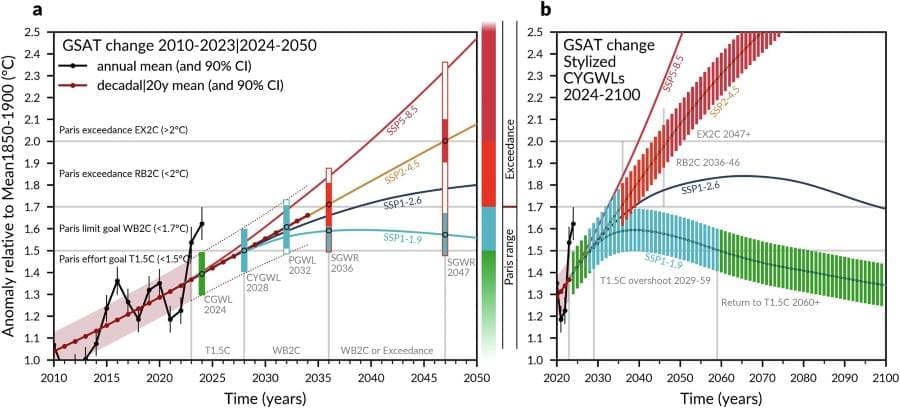Summary:
Global warming is on track to breach the 1.5 °C threshold as early as 2028, according to a new study published in Communications Earth & Environment by researchers at the University of Graz.
Using a revised benchmark timeseries covering the period from 1850 to 2024 and projecting forward to 2034, the team reports an annual global surface air temperature rise of 1.62 °C in 2024, with the 20-year average expected to cross 1.5 °C by 2028. This critical metric, used by the Intergovernmental Panel on Climate Change (IPCC) to monitor progress toward the Paris Agreement goals, now appears closer to its limit than previously estimated. Lead author Gottfried Kirchengast explains: “Our new results show that we will exceed this limit as early as 2028 – with a standard deviation range of plus/minus two years.”
The updated record, based on improved integration of ocean and atmospheric data, shows a 6% higher warming rate than conventional methods and distinguishes human-induced warming from natural variability. The researchers also propose a four-tier classification system to measure goal compliance, aiming to enhance clarity and accountability for policy and legal frameworks. They call for its integration into official climate tracking by the IPCC and World Meteorological Organization.

Researchers at the University of Graz enable reliable monitoring of Paris climate goals
In the Paris Agreement of 2015, the international community of countries agreed to limit global warming to well below 2 °C, and preferably to 1.5 °C, compared to pre-industrial levels. This refers to the increase in global surface air temperature, inspected at any time of interest as an average over 20 years. The latest IPCC report expected the 1.5 °C threshold to be reached between 2030 and 2035.
Climate researcher Gottfried Kirchengast from the Wegener Center and Institute of Physics at the University of Graz now has to revise this estimate: “Our new results show that we will exceed this limit as early as 2028 – with a standard deviation range of plus/minus two years. The benchmark record we have developed shows the global temperature rise with unprecedented reliability and therefore allows us for the first time to also propose an assessment scale to verify whether the Paris climate goals are being met or missed.”
Reference standard for global warming
Over the oceans, conventional monitoring of global warming does not use the air temperature above the water surface, but rather the temperature of the top few meters of seawater, such as recorded directly by drifting buoys. This results in an uncertainty that could not be properly corrected so far. The researchers at the University of Graz have now succeeded in doing so.
Based on the best available data sources from international climate centers, they computed a new benchmark record for the period from 1850 to 2024, complemented by predictions up to 2034 and scenarios to 2050.
“Our data show a six percent higher increase in global surface air temperature than the conventional monitoring,” says Kirchengast.
“And we can distinguish the human-induced temperature increase from specific climate phenomena like El Niño and other natural fluctuations, and predict the annual mean temperature of any current year, such as now for 2025, as early as from August,” adds the co-author of the publication, Moritz Pichler from the Wegener Center.

Compliance assessment for the Paris Agreement
Building on the reliable monitoring of global warming, the researchers propose a four-classes assessment scale to quantitatively gauge to what degree the Paris climate goals are being met or missed.
“This creates a completely new compliance assessment basis for the political and legal implementation of the agreement,” explains Kirchengast. He suggests further standardization in the context of the World Meteorological Organization and the IPCC, to provide it as an official assessment method for the Paris Agreement member countries.
“It is important to provide clarity for the Paris climate goals so that policymakers and all of us know where we actually stand and what it needs to meet them,” emphasizes the researcher, proposing as a complement to the 1.5° C goal that the imprecise wording ‘well below 2 °C’ be firmly defined as ‘below 1.7 °C’.
“It is high time to make these internationally binding targets for limiting global warming truly measurable and verifiable in order to underpin the urgently needed climate action by a generally valid climate-physics foundation,” concludes Kirchengast.
Journal Reference:
Kirchengast, G., Pichler, M., ‘A traceable global warming record and clarity for the 1.5 °C and well-below-2 °C goals’, Communications Earth & Environment 6, 402 (2025). DOI: 10.1038/s43247-025-02368-0
Article Source:
Press Release/Material by Gudrun Pichler | University of Graz
Featured image credit: user6702303 | Freepik




